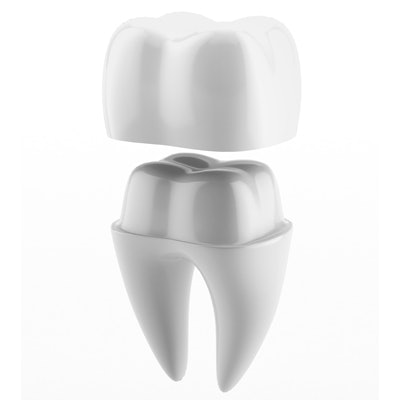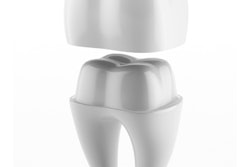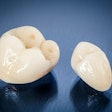
CAD/CAM blocks have evolved considerably in terms of materials, shade, and durability. But how well do different kinds of blocks stand up to professional dental prophylaxis?
Researchers conducted a study to see how the equivalent of one year of prophylaxis affected the surface gloss and roughness of both resin composite and zirconia-reinforced lithium silicate CAD/CAM blocks. Overall, polishing with a prophylactic paste led to what they called a "significant reduction" in surface gloss and an increase in surface roughness among resin composite blocks, whereas the lithium silicate blocks held up somewhat better.
"Our present results also revealed that the content, size, and shape of filler particles affect the postpolish surface gloss and roughness of CAD/CAM composite blocks," the authors wrote in the Journal of Clinical and Experimental Dentistry (June 1, 2017).
The study was led by Dr. Toshiko Sugiyama, a senior assistant professor in the division of general dentistry at the Tokyo Dental College Chiba Hospital in Japan.
Surface texture
As metal-free restorations have become more popular, it's not exactly known how the surface texture of restorative materials is affected by professional dental prophylaxis. Researchers sought to find out what effect prophylaxis had on two types of CAD/CAM composite blocks and two types of CAD/CAM ceramic blocks by comparing prophylaxis-induced changes in surface roughness and gloss.
They initially thought that the preprophylaxis surface texture would not differ significantly among the four CAD/CAM restorative materials and that the prophylaxis would have no significant effect on the surface texture of these restorative materials.
The researchers used two types of CAD/CAM composite resin blocks (Shofu Block HC, Shofu Dental; Estelite Block, Tokuyama Dental) and two types of CAD/CAM ceramic blocks (IPS Empress CAD, Ivoclar Vivadent; Celtra Duo, Dentsply Sirona).
The researchers cut each CAD/CAM material was cut into 20 disks, each approximately 3-mm thick. They then ground the samples using waterproof abrasive papers, then polished them using alumina suspensions of 0.3 nm and 0.05 nm.
They randomly divided the samples into four groups (n = 5) for the following prophylaxis procedures:
- Group 1: Mechanical cleaning with Merssage Regular (Shofu Dental) for 10 seconds four times
- Group 2: Four cycles of mechanical cleaning with Merssage Regular for 10 seconds and Merssage Fine (Shofu Dental) for 10 seconds
- Group 3: Four cycles of mechanical cleaning with Merssage Regular for 10 seconds and Merssage Fine for 30 seconds
- Group 4: Mechanical cleaning with Merssage Fine for 10 seconds four times
The team used a glossmeter to measure surface gloss before and after mechanical cleaning and used a contact stylus profilometer to measure surface roughness.
A disposable petri dish was placed on a platform on kitchen scales, and 0.5 mL of prophylaxis paste was applied to the center of the sample. Prophylaxis was done by mounting Merssage Brush No. 2 (Shofu Dental) on a 16:1 contra-angle slow-speed handpiece and operating the brush at 2,500 revolutions per minute (rpm) and a load gauge factor of 200. After every prophylaxis procedure, the sample was washed with water and was air-dried.
The researchers reported that polishing with prophylactic paste led to a significant reduction in surface gloss and increase in surface roughness in the resin composite blocks. However, the polishing-related change in surface gloss or roughness was smaller in Celtra Duo, the zirconia-reinforced lithium silicate block.
The Celtra Duo had a significantly higher surface gloss (p < 0.05) before and after prophylaxis than the other materials (see table), while the Shofu block HC had a significantly lower surface gloss and higher surface roughness (p < 0.05). The researchers found no significant change in weight after prophylaxis in any of the blocks.
| Difference in surface gloss before and after prophylaxis |
|||
| Blocks | Baseline | After prophylaxis |
Difference |
| Shofu Block HC | |||
| Group 1 | 56.1 | 27.2 | 29.0 |
| Group 2 | 58.4 | 37.4 | 21.0 |
| Group 3 | 63.1 | 37.3 | 25.8 |
| Group 4 | 68.1 | 67.3 | 0.8 |
| Estelite Block | |||
| Group 1 | 81.0 | 60.5 | 20.5 |
| Group 2 | 83.4 | 63.6 | 19.8 |
| Group 3 | 81.0 | 56.1 | 24.9 |
| Group 4 | 81.5 | 79.4 | 2.1 |
| IPS Empress CAD | |||
| Group 1 | 79.6 | 71.6 | 8.0 |
| Group 2 | 77.2 | 69.7 | 7.5 |
| Group 3 | 82.4 | 75.1 | 7.3 |
| Group 4 | 83.4 | 80.5 | 3.0 |
| Celtra Duo | |||
| Group 1 | 93.3 | 92.5 | 0.8 |
| Group 2 | 92.0 | 89.9 | 2.1 |
| Group 3 | 87.8 | 89.3 | 1.5 |
| Group 4 | 91.0 | 89.0 | 1.9 |
Difficult to differentiate
The study authors wrote that because of the development of composite resin materials that are as smooth and shiny as ceramic materials, it can be difficult for practitioners to distinguish composite resin materials from ceramic materials at first glance.
They also noted that their findings revealed that the effect of professional dental prophylaxis depends on the basic composition of ceramics.
"Therefore, preventive measures should be provided only after fully understanding the condition of plaques, teeth, and periodontal tissue, and considering the properties of preexisting restorative materials and prosthetic devices in the oral cavity," the authors concluded.



















